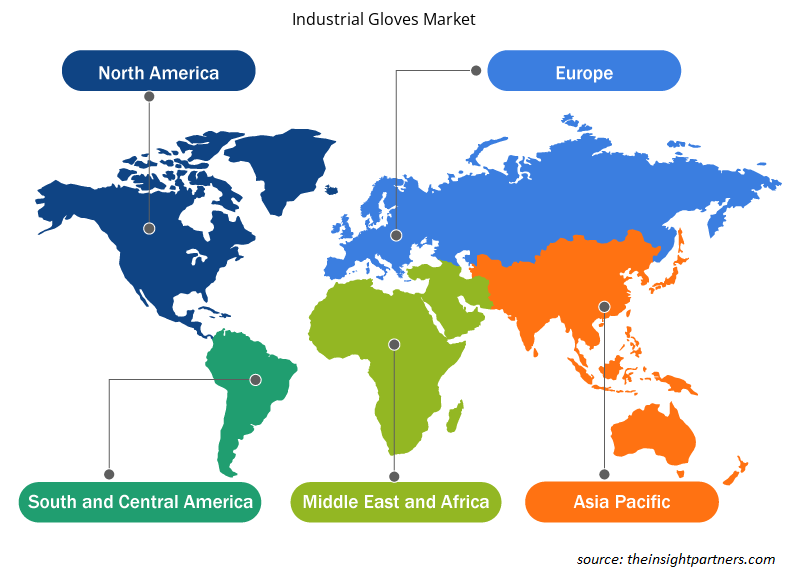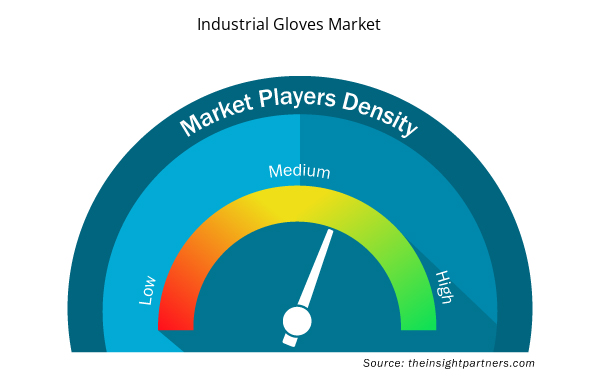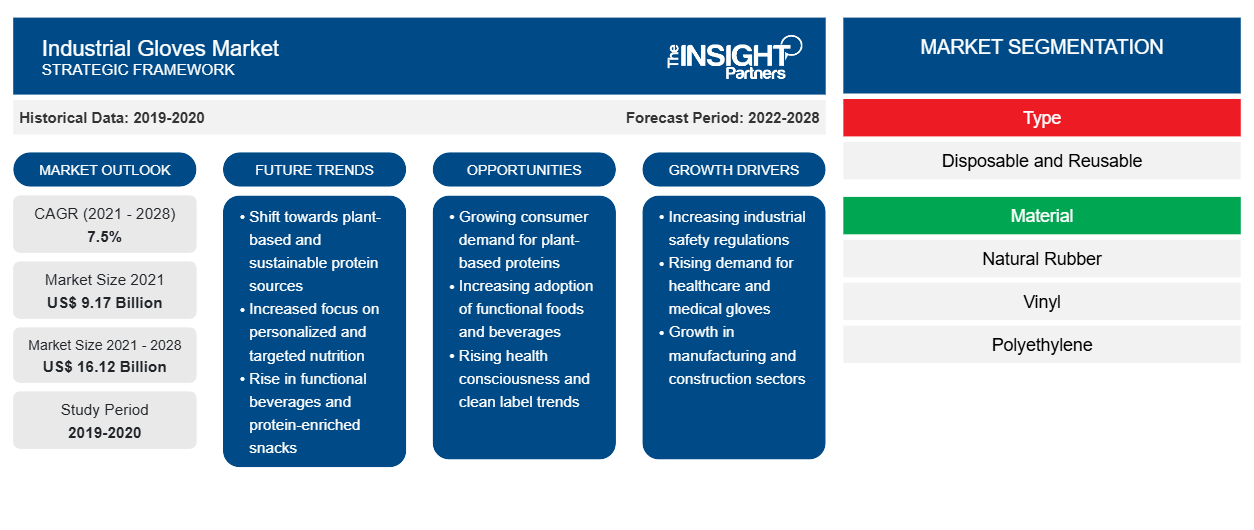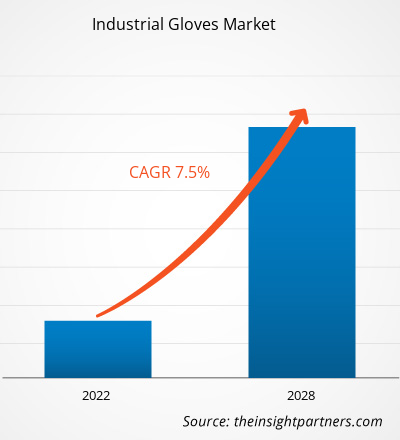[연구 보고서] 산업용 장갑 시장은 2021년에 9,174.06백만 달러 규모였으며, 2028년까지 16,119.54백만 달러에 도달할 것으로 예상되며, 2021년부터 2028년까지 연평균 성장률 7.5%로 성장할 것으로 예상됩니다.
산업용 장갑은 제조, 건설, 식품 및 음료, 석유 및 가스, 제약 등 다양한 산업에서 많이 사용됩니다. 모든 산업은 고유한 안전 표준 및 장비를 사용합니다. 따라서 다른 산업에는 다른 장갑이 필요합니다.
2020년 아시아 태평양 지역은 글로벌 시장에서 가장 큰 매출 점유율을 차지했습니다. 제조업, 식음료, 건설, 의료 등의 산업에서 장갑에 대한 수요가 높아 아시아 태평양 지역의 장갑 시장 성장을 주도하고 있습니다. 또한 이 지역은 말레이시아, 태국, 인도네시아, 인도, 중국과 같은 국가로 구성되어 있으며, 이들은 고무의 주요 생산국입니다. 천연 고무의 풍부한 가용성으로 인해 이 지역은 산업용 장갑 제조를 위한 주요 지역 중 하나가 되었습니다. 또한 말레이시아에서는 고무 장갑 산업과 고무 부문이 경제의 핵심 기둥으로 여겨집니다. 말레이시아의 고무 장갑 산업은 정부로부터 지속적인 지원을 받고 있습니다.
귀하의 요구 사항에 맞게 이 보고서를 사용자 정의하세요
이 보고서의 일부 또는 국가 수준 분석, Excel 데이터 팩을 포함하여 모든 보고서에 대한 사용자 정의를 무료로 받을 수 있으며 신생 기업 및 대학을 위한 훌륭한 혜택과 할인 혜택을 이용할 수 있습니다.
- 이 보고서의 주요 시장 동향을 알아보세요.이 무료 샘플에는 시장 동향부터 추정 및 예측까지 다양한 데이터 분석이 포함됩니다.
산업용 장갑 시장에 대한 COVID-19 팬데믹의 영향
COVID-19 팬데믹은 봉쇄, 여행 금지 및 사업 중단으로 인해 다양한 국가의 경제와 산업에 영향을 미쳤습니다. 2020년에는 국가 및 국제 경계가 폐쇄되어 가치 사슬이 중단되어 다양한 산업이 운영을 늦춰야 했고, 이로 인해 다양한 산업에서 산업용 장갑에 대한 수요가 감소했습니다. COVID-19 팬데믹으로 인해 산업용 장갑을 생산하는 데 필요한 원자재 가격이 변동되었습니다. 건설 및 제조와 같은 다양한 산업의 수요가 낮아 산업용 장갑의 전 세계 소비가 감소했습니다. COVID-19 팬데믹으로 인해 다양한 산업의 수요가 감소하여 산업용 장갑 시장 성장에 부정적인 영향을 미쳤습니다 . 그러나 COVID-19의 시작으로 의료 산업의 장갑을 포함한 개인 보호 장비(PPE)에 대한 수요가 증가했습니다.
시장 통찰력
다양한 산업에서 장갑 사용 증가
손 부상은 가장 흔한 직장 부상 중 하나입니다. 장갑과 같은 개인 보호 장비(PPE)를 사용하면 예방할 수 있습니다. 장갑을 포함한 다양한 개인 보호 장비에 대한 수요를 창출하는 주요 요인은 안전에 대한 직장 인식을 높이는 것입니다.
장갑은 화학 산업에서 화학 물질 및 기타 유해 액체로부터 보호합니다. 장갑은 또한 근로자가 오일 및 기타 윤활제를 다루어야 하는 곳에서 사용됩니다. 장갑은 고온에 대한 우수한 단열성을 제공하므로 내열성 장갑은 용접, 금속 가공, 단조 및 관련 작업에 광범위하게 사용됩니다. 따라서 안전 절차 준수 증가와 장갑의 여러 이점이 다양한 산업에서 적용이 증가하고 있습니다.
유형 통찰력
유형에 따라 글로벌 시장은 일회용 및 재사용으로 세분화됩니다. 일회용 세그먼트는 2020년에 글로벌 시장에서 더 큰 점유율을 차지했습니다. 일회용 장갑은 니트릴, 천연 고무, 네오프렌, 비닐을 포함한 다양한 소재를 사용하여 개발되고 있습니다. 일회용 장갑은 석유 및 가스, 식품 및 음료, 건설, 의료, 화학을 포함한 다양한 산업에서 사용되고 있습니다.
산업용 장갑 시장, 유형별 – 2020년 및 2028년
최종 사용 산업을 기준으로 시장은 제조, 건설, 식품 및 음료, 석유 및 가스, 제약 및 기타로 세분화됩니다. 제조 부문은 2020년 글로벌 시장에서 가장 큰 점유율을 차지했습니다. 제조 산업에서 산업용 장갑은 안전을 위해 산업용 장갑이 필요한 생산을 위한 중장비 사용이 포함되므로 많이 사용됩니다. 노동력 증가와 제조 산업의 노동 존재로 인해 전 세계적으로 산업용 장갑 수요가 증가했습니다.
3M; Ansell Limited; Carolina Glove & Safety Company; Cementex Products, Inc.; Cintas Corporation; Honeywell International Inc.; International Plastics Inc.; Southern Glove, Inc.; Superior Glove; Workwear Outfitters, LLC는 글로벌 산업용 장갑 시장에서 활동하는 주요 기업 중 일부입니다. 글로벌 산업용 장갑 시장에서 활동하는 기업은 연구 개발 활동 및 신제품 출시에 대한 투자와 같은 전략에 지속적으로 집중하고 있습니다. 이러한 시장 기업은 고객의 요구 사항을 충족하기 위해 고품질의 혁신적인 제품을 개발하는 데 매우 집중하고 있습니다.
산업용 장갑 시장 지역 통찰력
Insight Partners의 분석가들은 예측 기간 동안 산업용 장갑 시장에 영향을 미치는 지역적 추세와 요인을 철저히 설명했습니다. 이 섹션에서는 북미, 유럽, 아시아 태평양, 중동 및 아프리카, 남미 및 중미의 산업용 장갑 시장 세그먼트와 지리에 대해서도 설명합니다.

- 산업용 장갑 시장에 대한 지역별 특정 데이터 얻기
산업용 장갑 시장 보고서 범위
| 보고서 속성 | 세부 |
|---|---|
| 2021년 시장 규모 | 91억 7천만 달러 |
| 2028년까지 시장 규모 | 161억 2천만 달러 |
| 글로벌 CAGR (2021-2028) | 7.5% |
| 역사적 데이터 | 2019-2020 |
| 예측 기간 | 2022-2028 |
| 다루는 세그먼트 | 유형별로
|
| 포함된 지역 및 국가 | 북아메리카
|
| 시장 선도 기업 및 주요 회사 프로필 |
|
시장 참여자 밀도: 비즈니스 역학에 미치는 영향 이해
산업용 장갑 시장은 소비자 선호도의 변화, 기술 발전, 제품의 이점에 대한 인식 증가와 같은 요인으로 인해 최종 사용자 수요가 증가함에 따라 빠르게 성장하고 있습니다. 수요가 증가함에 따라 기업은 제품을 확장하고, 소비자의 요구를 충족하기 위해 혁신하고, 새로운 트렌드를 활용하여 시장 성장을 더욱 촉진하고 있습니다.
시장 참여자 밀도는 특정 시장이나 산업 내에서 운영되는 회사나 기업의 분포를 말합니다. 주어진 시장 공간에 얼마나 많은 경쟁자(시장 참여자)가 존재하는지 그 규모나 전체 시장 가치에 비해 나타냅니다.
산업용 장갑 시장에서 활동하는 주요 회사는 다음과 같습니다.
- 앤셀 리미티드
- 케어플러스 그룹 베르하드
- 글로버스 그룹
- 하르탈레가 홀딩스 BHD
- 허니웰 인터내셔널 주식회사
면책 조항 : 위에 나열된 회사는 어떤 특별한 순서에 따라 순위가 매겨지지 않았습니다.

- 산업용 장갑 시장의 주요 주요 업체 개요를 알아보세요
스포트라이트 보고서
- 산업용 장갑 시장의 진보적인 산업 동향은 플레이어가 효과적인 장기 전략을 개발하는 데 도움이 됩니다.
- 선진국과 개발도상국 시장에서 채택한 사업 성장 전략
- 2019년부터 2028년까지 산업용 장갑 시장의 정량적 분석
- 산업용 장갑에 대한 세계 수요 추산
- 산업에서 운영되는 구매자와 공급자의 효율성을 설명하기 위한 포터의 5가지 힘 분석
- 경쟁 시장 시나리오를 이해하기 위한 최근 개발
- 산업용 장갑 시장 성장을 주도하고 제한하는 요인과 더불어 시장 동향 및 전망
- 상업적 이익을 뒷받침하는 시장 전략을 강조하여 의사 결정 과정을 지원하고 시장 성장을 이끕니다.
- 다양한 노드에서의 산업용 장갑 시장 규모
- 시장의 자세한 개요 및 세분화, 산업용 장갑 산업 역학
- 유망한 성장 기회가 있는 다양한 지역의 산업용 장갑 시장 규모
글로벌 산업용 장갑 시장
유형
- 일회용의
- 재사용 가능
재료
- 천연고무
- 비닐
- 폴리에틸렌
- 니트릴
- 기타
최종 사용 산업
- 조작
- 건설
- 음식 & 음료
- 석유 및 가스
- 제약
- 기타
회사 프로필
- 3M
- 앤셀 리미티드
- 캐롤라이나 글러브 & 세이프티 컴퍼니
- 세멘텍스 프로덕트 주식회사
- 신타스 코퍼레이션
- 허니웰 인터내셔널 주식회사
- 인터내셔널 플라스틱 주식회사
- 사우던글러브 주식회사
- 우수한 장갑
- 워크웨어 아웃피터스, LLC
- 역사적 분석(2년), 기준 연도, CAGR을 포함한 예측(7년)
- PEST 및 SWOT 분석
- 시장 규모 가치/양 - 글로벌, 지역, 국가
- 산업 및 경쟁 환경
- Excel 데이터 세트


- Electronic Toll Collection System Market
- Nitrogenous Fertilizer Market
- Smart Grid Sensors Market
- Enzymatic DNA Synthesis Market
- Semiconductor Metrology and Inspection Market
- Medical Second Opinion Market
- Dealer Management System Market
- Retinal Imaging Devices Market
- Helicopters Market
- Photo Printing Market

Report Coverage
Revenue forecast, Company Analysis, Industry landscape, Growth factors, and Trends

Segment Covered
This text is related
to segments covered.

Regional Scope
North America, Europe, Asia Pacific, Middle East & Africa, South & Central America

Country Scope
This text is related
to country scope.
자주 묻는 질문
Increasing use of gloves in various industries is one of the major driving factors for the market. A hand injury is one of the most common workplace injuries. It can be prevented by using personal protection equipment (PPE), such as gloves. Increasing awareness about safety at workplaces is creating demand for different personal protection equipment, including gloves.
Asia Pacific (APAC) is anticipated to grow with the fastest CAGR from 2021 to 2028. The region is witnessing high growth in construction activities which is fueling the demand for construction gloves. In addition to this, the region is foreseeing a rapid industrialization which is fostering the need of various material of industrial gloves.
Based on material, the natural rubber segment accounted the largest share of the global industrial gloves market. Rubber hand gloves are being used in various industrial and medical applications. They are made of different types of rubber, depending upon the application. These gloves help protect the hands from chemicals, hot water, dust, oil, or icky substances.
Due to the COVID-19 pandemic, industrial gloves manufacturers witnessed a major disruption in the supply chain of industrial gloves during the first two quarters of 2020. However, the supply chain of industrial gloves materials has been restored, and production activities have regained normalcy in late 2020. Later, the market was not significantly negatively impacted by the pandemic. Further, with the growing COVID-19 vaccinations and eased in lockdown restrictions, the global economy is resuming, and subsequently, the industrial gloves market is regaining its growth.
During the forecast period, APAC is anticipated to account for the largest share in the global industrial gloves market. The growth of the market in the region can be attributed to the rapid industrialization in the region along with increasing expenditures on healthcare industry.
The major players operating in the global industrial gloves market are Ansell Limited, Careplus Group Berhad, Globus Group, Hartalega Holdings BHD, Honeywell International Inc, Kossan Rubber Industries BHD, Riverstone Holdings Limited, Semperit AG Holding, Supermax Corporation Berhad, and Top Glove Corporation BHD.
Trends and growth analysis reports related to Chemicals and Materials : READ MORE..
The List of Companies - Industrial Gloves Market
- ANSELL LIMITED
- CAREPLUS GROUP BERHAD
- GLOBUS GROUP
- HARTALEGA HOLDINGS BHD
- HONEYWELL INTERNATIONAL INC
- KOSSAN RUBBER INDUSTRIES BHD
- RIVERSTONE HOLDINGS LIMITED
- SEMPERIT AG HOLDING
- SUPERMAX CORPORATION BERHAD
- TOP GLOVE CORPORATION BHD
The Insight Partners performs research in 4 major stages: Data Collection & Secondary Research, Primary Research, Data Analysis and Data Triangulation & Final Review.
- Data Collection and Secondary Research:
As a market research and consulting firm operating from a decade, we have published and advised several client across the globe. First step for any study will start with an assessment of currently available data and insights from existing reports. Further, historical and current market information is collected from Investor Presentations, Annual Reports, SEC Filings, etc., and other information related to company’s performance and market positioning are gathered from Paid Databases (Factiva, Hoovers, and Reuters) and various other publications available in public domain.
Several associations trade associates, technical forums, institutes, societies and organization are accessed to gain technical as well as market related insights through their publications such as research papers, blogs and press releases related to the studies are referred to get cues about the market. Further, white papers, journals, magazines, and other news articles published in last 3 years are scrutinized and analyzed to understand the current market trends.
- Primary Research:
The primarily interview analysis comprise of data obtained from industry participants interview and answers to survey questions gathered by in-house primary team.
For primary research, interviews are conducted with industry experts/CEOs/Marketing Managers/VPs/Subject Matter Experts from both demand and supply side to get a 360-degree view of the market. The primary team conducts several interviews based on the complexity of the markets to understand the various market trends and dynamics which makes research more credible and precise.
A typical research interview fulfils the following functions:
- Provides first-hand information on the market size, market trends, growth trends, competitive landscape, and outlook
- Validates and strengthens in-house secondary research findings
- Develops the analysis team’s expertise and market understanding
Primary research involves email interactions and telephone interviews for each market, category, segment, and sub-segment across geographies. The participants who typically take part in such a process include, but are not limited to:
- Industry participants: VPs, business development managers, market intelligence managers and national sales managers
- Outside experts: Valuation experts, research analysts and key opinion leaders specializing in the electronics and semiconductor industry.
Below is the breakup of our primary respondents by company, designation, and region:

Once we receive the confirmation from primary research sources or primary respondents, we finalize the base year market estimation and forecast the data as per the macroeconomic and microeconomic factors assessed during data collection.
- Data Analysis:
Once data is validated through both secondary as well as primary respondents, we finalize the market estimations by hypothesis formulation and factor analysis at regional and country level.
- Macro-Economic Factor Analysis:
We analyse macroeconomic indicators such the gross domestic product (GDP), increase in the demand for goods and services across industries, technological advancement, regional economic growth, governmental policies, the influence of COVID-19, PEST analysis, and other aspects. This analysis aids in setting benchmarks for various nations/regions and approximating market splits. Additionally, the general trend of the aforementioned components aid in determining the market's development possibilities.
- Country Level Data:
Various factors that are especially aligned to the country are taken into account to determine the market size for a certain area and country, including the presence of vendors, such as headquarters and offices, the country's GDP, demand patterns, and industry growth. To comprehend the market dynamics for the nation, a number of growth variables, inhibitors, application areas, and current market trends are researched. The aforementioned elements aid in determining the country's overall market's growth potential.
- Company Profile:
The “Table of Contents” is formulated by listing and analyzing more than 25 - 30 companies operating in the market ecosystem across geographies. However, we profile only 10 companies as a standard practice in our syndicate reports. These 10 companies comprise leading, emerging, and regional players. Nonetheless, our analysis is not restricted to the 10 listed companies, we also analyze other companies present in the market to develop a holistic view and understand the prevailing trends. The “Company Profiles” section in the report covers key facts, business description, products & services, financial information, SWOT analysis, and key developments. The financial information presented is extracted from the annual reports and official documents of the publicly listed companies. Upon collecting the information for the sections of respective companies, we verify them via various primary sources and then compile the data in respective company profiles. The company level information helps us in deriving the base number as well as in forecasting the market size.
- Developing Base Number:
Aggregation of sales statistics (2020-2022) and macro-economic factor, and other secondary and primary research insights are utilized to arrive at base number and related market shares for 2022. The data gaps are identified in this step and relevant market data is analyzed, collected from paid primary interviews or databases. On finalizing the base year market size, forecasts are developed on the basis of macro-economic, industry and market growth factors and company level analysis.
- Data Triangulation and Final Review:
The market findings and base year market size calculations are validated from supply as well as demand side. Demand side validations are based on macro-economic factor analysis and benchmarks for respective regions and countries. In case of supply side validations, revenues of major companies are estimated (in case not available) based on industry benchmark, approximate number of employees, product portfolio, and primary interviews revenues are gathered. Further revenue from target product/service segment is assessed to avoid overshooting of market statistics. In case of heavy deviations between supply and demand side values, all thes steps are repeated to achieve synchronization.
We follow an iterative model, wherein we share our research findings with Subject Matter Experts (SME’s) and Key Opinion Leaders (KOLs) until consensus view of the market is not formulated – this model negates any drastic deviation in the opinions of experts. Only validated and universally acceptable research findings are quoted in our reports.
We have important check points that we use to validate our research findings – which we call – data triangulation, where we validate the information, we generate from secondary sources with primary interviews and then we re-validate with our internal data bases and Subject matter experts. This comprehensive model enables us to deliver high quality, reliable data in shortest possible time.


 이 보고서에 대한 무료 샘플을 받으세요
이 보고서에 대한 무료 샘플을 받으세요